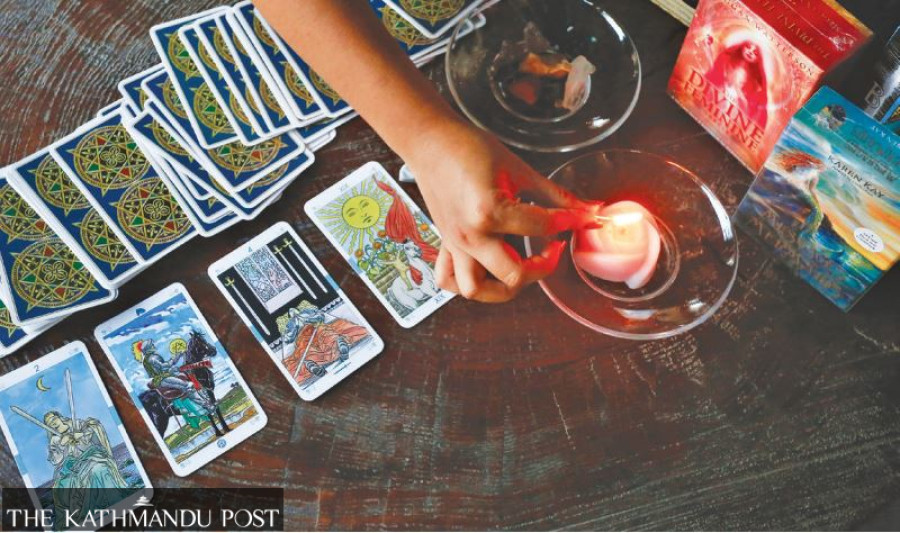National
How tarot card readings are getting popular among Nepali youths
The pandemic provided an opportunity for these new readers just while there were clients, and social media became the tool.
Aakriti Ghimire
Dipasa Bista hopped on a video call over Instagram. On the other side was a tarot reader. Bista saw the reader burn incense sticks and candles before shuffling a deck of cards—with illustrations of blue and gold—twice the size of normal playing cards. As Bista asked questions, the reader picked cards “to read”.
“She did some cleansing in the beginning, and from that very moment, it felt as though a sense of calmness had engulfed me,” said Bista, 24. “Of course, I was nervous, but also felt assured.”
In a country with a deep fascination with fortune-telling through natal chart readings, the pandemic has imported an ancient Western methodology of predicting the future through a set of cards—the tarot cards. Since the first lockdown, tarot card reading has drawn the attention of many Nepali youngsters. Young tarot card readers began using various social media platforms to provide paid services. Amidst the confusion and uncertainty brought by the pandemic, tarot cards became a way for the young to seek clarity on “their future”.
“A lot of curiosity and naiveness led me to book my tarot reading, quite impulsively,” shared Bista, a grants management and fundraising professional who booked her first reading after she heard of it from her sister.
During the second lockdown, Niharika Singh, an animator by profession, randomly ended up on a tarot card reader’s Instagram page. Curious, Singh booked her first tarot reading appointment.
“I was very fascinated by the idea of getting a reading done. We hopped on a call over Instagram,” Singh chuckled.
Tarot card readers have availed social media platforms—such as Instagram, TikTok, Clubhouse—to advertise their services. Readers’ Instagram pages had dedicated sections for testimonials from their clients, information on tarotology, and links to book readings with information on their charges.
Smriti Shrestha, 23, who runs the Instagram handle @konegin_, started her tarot reading journey in March 2020. She began uploading her tarot card videos on TikTok and did sessions on Clubhouse. “Clubhouse became a great platform for me to find my clients. After my first session on Clubhouse, I had over a hundred requests for readings on my Instagram.”
While Shrestha uses her personal handle to do readings, readers also have dedicated pages.
@Thetarotells is an Instagram page with a following of over 1,100, run by Oshin Thapa Magar who studies Food Technology at NIST (National Institute of Science and Technology) College. Magar also started reading tarot virtually during the first lockdown. Her clients were mostly friends in the beginning. Her services now have expanded through word-of-mouth.
“And as my clientele grew, I had to open my Instagram page. Ever since it has been an exciting journey,” says Magar.
Tarot cards are a deck of 78 cards that are used for divination purposes. Tarot cards were first designed as playing cards, which later were used for divinatory purposes. Readers read the deck using their intuitive talents in deciphering the meanings and messages.
Youngsters are attracted to tarot readings, not just for fortune-telling though. They find it entertaining, a fun activity. “It has now become ‘a thing’ among the youngsters, and it is actually pretty fun,” says Singh who has done tarot readings twice. “I was feeling unproductive anyway, so the reading gave me a sense of clarity, and that was very relaxing.”
“Tarot card is a guidance tool,” says Sneha Agarwal, a certified tarot reader who manages @thereader556 on Instagram. “It helps you navigate through life circumstances better,” said Agarwal who is currently based in Dharan.
Magar, 23, has been reading tarot cards for almost two years now. “Tarot is a means of communication. It’s a medium to receive messages from our spirit guides, and ancestors, and to mediate them to the clients,” she said.
All tarot readers the Post spoke with were fascinated by astrology and spirituality prior to becoming tarot card readers. The pandemic gave them an opportunity to spend time enhancing their skills—either through online courses or by doing readings for their friends.
“I was always into astrology, mostly Western, and then somehow I started watching a lot of tarot reading videos online by the end of 2019. Eventually, I learned to read the cards during the first few months of the pandemic,” said Shrestha who is currently pursuing her Masters in Social Work at St Cloud State University, USA.
Agarwal even took two online classes on Udemy to become certified in advanced tarot and face reading.

Social media platforms and the internet have played a crucial role to popularise tarot reading in Nepal. The easy accessibility of readers through these platforms and their algorithms have benefitted both the readers and the clients.
Singh’s friends had been wanting to get a cheena reading for years now, but they haven’t been able to do so. “For a cheena reading, we usually go with our parents and we can’t even ask questions we want. But with tarot readers, they are very easily accessible, and now a lot of my friends are opting for that.”
Birth charts, colloquially known as cheena, are very popular in Nepali culture. Agarwal believes that the prevalent culture and belief in fortune-telling has allowed tarot reading to flourish in Nepal.
Agarwal has already done readings for about 800 people, Shrestha has done readings for above 200 people and Magar has read for about 1,000 people, as of now, they say.
The audience of the tarot card readers isn’t confined to Nepal only. Agarwal’s clientele base is mostly in Nepal but they are in India too. Shrestha’s clientele base is in Nepal and the Nepali diaspora in the US. Likewise, Magar’s clients are in Nepal, the US, the UK, and Dubai. They have done readings for mostly young audiences—aged eighteen to mid-thirties—across the world.
Shrestha hypothesises that this popularity of tarot readers among the youth is mostly because of curiosity, uncertainty, and confusion induced by the pandemic.
Magar believes the pandemic was a shock to everyone.
“We all are confused and scared of the uncertain future. Perhaps, that is why most of my clients were curious... about their career or about relationships,” she said.
However, all readers interviewed by the Post could not read the cards on the get-go. They struggled initially to interpret the meanings of the cards, but over time, their confidence in themselves grew as their predictions began coming to fruition.
“I made a prediction for my friend and when that prediction came true, and other predictions started coming true, I realised that there can’t be those many coincidences,” said Agarwal. “And that’s when I started becoming more confident in my intuitive abilities.”
Shrestha shared a similar story.
“I was perplexed and amazed when my predictions came true. That made me realise that, maybe, I was underestimating my abilities,” she said.
Despite that, the readers emphasise that they can’t guarantee their predictions will be realised. “They caution you to take it with a grain of salt,” said Singh.
All the readers have varying amounts that they charge their clients for their services. Agarwal’s charges vary from Rs320-1,600, Magar’s charges vary from Rs500-700, and Shrestha’s charges vary from Rs1,000-9,000. Charges are determined based on the number of questions, areas of interest, and time for reading.
As professional tarot readers, all three readers shared with the Post that they have made good money with tarot readings.
“I have always ensured from my clients that they find the charge worth the reading,” said Shrestha who left Nepal a couple of months ago. “Before coming to the States, I was able to do most of my shopping from the savings via tarot reading.”
Tarot card reading has enabled these readers to become financially independent as well. By tapping into an unexplored arena of fortune-telling, both personally and professionally, the readers feel grateful for their financial independence, all the while pursuing their niche interests. They are optimistic about the growing popularity of tarot reading in Nepal.
Bista said that she really loved her tarot reading because “it revolved around the idea that everything is under our control and we can change our future, it’s just about taking the right path.”
“I will definitely get another reading done soon,” says Bista.




 10.12°C Kathmandu
10.12°C Kathmandu


%20(1).jpg&w=200&height=120)












